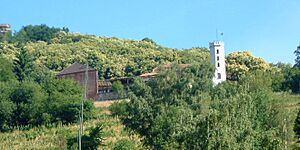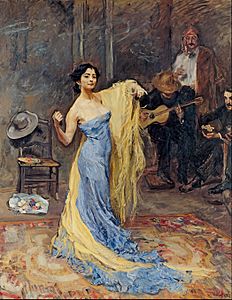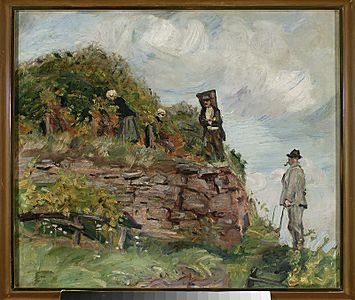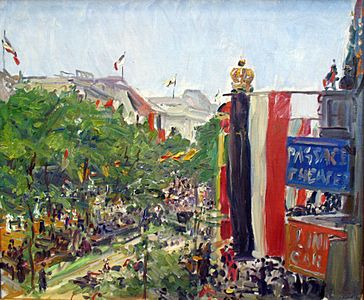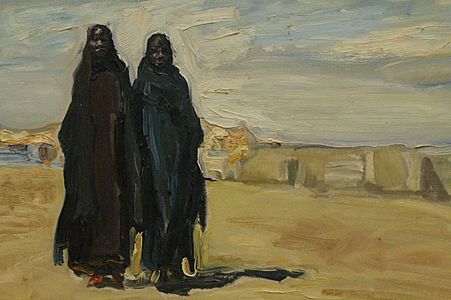Max Slevogt facts for kids
Quick facts for kids
Max Slevogt
|
|
|---|---|
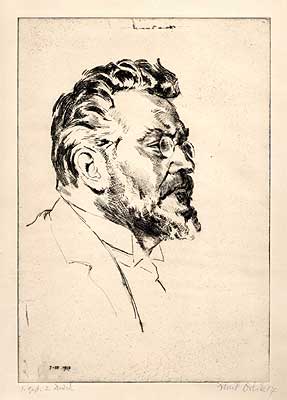
Slevogt portrayed in a 1917 etching
by Emil Orlik |
|
| Born | 8 October 1868 Landshut, Germany
|
| Died | 20 September 1932 (aged 63) Leinsweiler, Bavaria, Germany
|
| Nationality | German |
| Education | Munich Academy Académie Julian |
| Known for | Painter, scene designer |
| Movement | Orientalist |
Max Slevogt (born October 8, 1868 – died September 20, 1932) was a German painter and illustrator. He is famous for his Impressionist style. This means he used visible brushstrokes and focused on light. He was especially known for his landscape paintings.
Max Slevogt was one of Germany's top artists. He painted alongside Lovis Corinth and Max Liebermann. They were all known for painting outdoors, a style called plein air.
Contents
Max Slevogt's Life
Max Slevogt was born in Landshut, Germany, in 1868. He studied art at the Munich Academy from 1885 to 1889. His early paintings were often dark. This was a popular style in Munich at the time.
In 1889, Slevogt visited Paris, France. He attended the Académie Julian, another art school. Later, in 1896, he started drawing funny pictures, called caricatures. These were for magazines like Simplicissimus and Jugend. The next year, he had his first art show in Vienna.
His Art Style Changes
By the late 1890s, Slevogt's paintings became much brighter. He went back to Paris in 1900. One of his paintings, Scheherezade, was shown there. He was very impressed by the paintings of Édouard Manet. In 1901, he joined the Berlin Secession. This was a group of artists who wanted new ways of painting.
In 1914, Slevogt traveled to Egypt. This trip inspired 21 new oil paintings. They were very bright and fresh. He also made many watercolors and drawings. On his way home, he stopped in Italy. That same year, he bought a country home called Neukastel.
Art During Wartime
When World War I began, Slevogt became an official war painter. He was sent to the western front. His experiences in the war deeply affected him. He started looking for new ways to show the serious feelings of war in his art. In 1914, he also became a member of the Prussian Academy of Arts in Berlin.
In 1924, he designed the stage sets for Mozart's opera Don Giovanni. This was for a show in Dresden. His art was even part of the art competition at the 1928 Summer Olympics.
In 1929, he had a big art show in Berlin. It celebrated his 60th birthday. In his last year, he worked on a large religious painting. It was a mural called Golgatha. This mural was in a church in Ludwigshafen. Sadly, it was destroyed during World War II bombings.
Max Slevogt passed away in Leinsweiler, Germany, in 1932. He is buried near his home, the Slevogthof.
Artworks Returned to Families
In 2020, some of Max Slevogt's artworks were returned. They went back to the family of Julius Freund. His family was treated unfairly because they were Jewish. They were forced to sell their art during the Nazi era.
Here are some of the artworks that were returned:
- Francisco d'Andrade (Head Study), 1902, an oil painting.
- The Port of Brindisi, 1914, a watercolor.
- Li-Hung-Tschang, 1900, an ink drawing.
- Scheherezade tells her story to the Caliph, 1901, a pen drawing.
- Mungos, 1901, a watercolor pen drawing.
- Lamenting Women (Lamenting Women in front of a House), around 1898–1903, a pen and ink drawing.
Selected Paintings
-
Francisco d'Andrade as Don Giovanni (1912)
See also
 In Spanish: Max Slevogt para niños
In Spanish: Max Slevogt para niños


